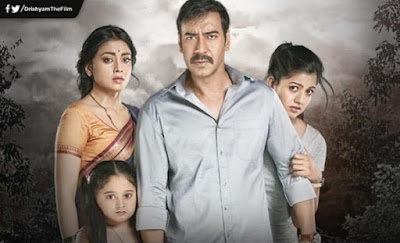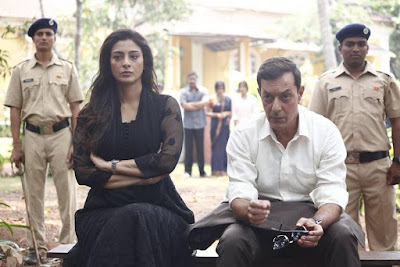By Anirban Lahiri
Featured in IMDb Critic Reviews
 |
| Drishyam (2015) - By Nishikant Kamat |
IMDb Ratings: 9.0
Genre: Drama | Mystery | Thriller
Cast: Ajay Devgn, Shriya Saran, Tabu
Country: India
Language: Hindi
Runtime: 163 min
Color: Color
Summary: Desperate measures are taken by a man who tries to save his family from the dark side of the law, after they commit an unexpected crime.
If ten national award winners, coming
together, give birth to a scourge like Drishyam, we would rather be satisfied
with films made by non-winners. The Tamil remake of the Malayalam film of the
same name was not saved in the persona of Kamal Hassan, earlier this year (Papasanam,
2015). Its Hindi remake with Ajay Devgan, Shriya Sharan and Tabu could not
salvage the lack of cohesion in the plot.
This is a plot-based film, unlike many
which rely largely on background story, subtexts and subplots. Plot means whatever is shown in the film
– the screened narrative, story means
anything else which is not shown but hinted – the unscreened gaps in the plot
that the viewers concoct in their mind in order to receive a logical
progression in the narrative. Subtexts
are the resources that provide the coherence in different value systems
followed by the characters and the story, background information, validity for
the expectations asserted by the characters in the story, historicity, inherent
logic of the story. Subplot is any
other lead, any other narrative line, which goes parallel to the main narrative
without any direct interference.
A plot-based film, such as Bahubali (2015), depends on the tautness
of the narration – how the story is told. In the classical screenplay
structure, the characters are developed in the first 25-30 minutes – the first
two sequences that lead to the problem that pushes (or motivates) the story
forward (classically called conflict).
Sometimes, the conflict comes out of a flaw in the character of the hero;
sometimes that appears accidentally due to fortuitous happenings in society, or
nature, presenting a survival challenge to the protagonist. Drishyam falls
under the second category.
Generally, the change-of-destiny type films present an elaborate study of the
hero’s character to show his qualities. However, minor challenges to test his
mettle must be dished out. Otherwise, the narration would be preachy, or flat.
Precisely that happened to Drishyam.
Ajay Devgan as Vijay Salgaonkar presents
a vapid character almost throughout the first half of the film. We come to know
he is a fourth class failed, orphan, hand-to-mouth labour who changed his status
to be a moderately successful cablewala, in the peaceful neighbourhood of
Condolim, Goa. We also come to know that Vijay is an ardent filmbuff, who sits
through nights at the office watching movies while his family keeps waiting for
him at home. This is the primary lack, or weakness, in his character that would
double up as the major strength in the later part of the story.
Throughout the first half, the film
drags through fragmented snapshots of everyday life pivoted around purposeless
movements of characters, cliché dialogue routines, poor jokes and impassionate
body language of the characters. It was interesting to begin the film through a
detour – almost a subplot. It is sad that the introductory character of the
police officer, new in town, plays no role in the film except for leading to
the character of Vijay where the story starts through flashback.
The Malayalam original, written and
directed by Jeethu Joseph, was the highest grossing film among all regional
movies, with ₹ 66.25
Cr collection on an official ₹ 4.5
Cr production budget. Mohanlal, with his
bloated physique, looked quite boring
(but less than Ajay Devgan’s Vijay Salgaonkar) in the first half of the
film. When it came to cracking the problem – setting the reality up
shot-by-shot just like a film – Mohanlal’s George Kutty turned to be far more
interesting than any any character in Hindi Drishyam, except the two irated
ones – Tabu in the role of the Inspector General of Police, Meera Deshmukh and
Kamlesh Sawant as Inspector Gaitonde. The Malayali Drishyam falls flat on this
count.
The Hindi version is almost a
frame-by-frame remake of the Malayali original. It differs from the Mohanlal
starrer in some puerile issues – such as, the full stripping of Vijay’s
daughter, Anju (played by Tanushree Dutta’s sister Ishita Dutta) showing her bare
back, or the dramatic entry by the IG played by Tabu. While the former produces
titillation and makes the audience sceptical at the same time – why a
post-pubescent school girl roams around in the summer camp, among boys, without
wearing a bra; the latter makes the IG’s character stereotype, stock. The
editing style enhances the stereotype and makes the film deliciously
predictable.
And there the film starts dragging, despite all the tropes and turns. Avinash Arun’s cinematography is way better than the original Drishyam’s, which was flat and ‘wrong’ at times. Yet, the visual betterment could not salvage the film. Musical intonations in both the films are pathetic. Yet, the Hindi film is making a good business just like the original did! At the end of the second Friday, it collected a whopping ₹ 49.03 Cr, with a last day collection of ₹ 2.73 Cr.
And there the film starts dragging, despite all the tropes and turns. Avinash Arun’s cinematography is way better than the original Drishyam’s, which was flat and ‘wrong’ at times. Yet, the visual betterment could not salvage the film. Musical intonations in both the films are pathetic. Yet, the Hindi film is making a good business just like the original did! At the end of the second Friday, it collected a whopping ₹ 49.03 Cr, with a last day collection of ₹ 2.73 Cr.
Surely, the Ajay Devgan starrer is
giving a tough time to Bajrangi Bhaijaan and Bahubali. It is interesting to
note that Drishyam has witnessed full house both in Mumbai and Kolkata, even on
the second Saturday. What is the secret?
Checking the circumstances, it makes
sense. The recent Mumbai moral policing may give a hike to the attendance for Masaan, as a token protest from the
public. Aristotle’s catharsis theory works more in the age of social media.
Drishyam talks about a purported crime by the common man and the subsequent
power-play with the police. In the age of globalization, internet and continued
comparative analysis of life and happiness, the middle class (lower and upper
included) are, in general, dissatisfied with the police, law and morality. The
salaried-income class wants its share of power, proportionate political
representation and freedom as regards privacy, morality and right to life.
Drishyam popularity may have something to do with that trend.
The plot outline is interesting. The
plot structure is not. Mounted like a detective movie, Drishyam lacks the pace,
body language (of the characters), dynamics (wrongly extended actions, poorly
placed plot points, badly mounted decoys) and finesse. There was a debate, and
a lawsuit by Ekta Kapoor, that the original Drishyam had been lifted from the
Japanese novel The Devotion of Suspect X
without declaration and permission. However, that claim is not totally true.
When it comes to restructuring the reality Drishyam may have received influence
from the Japanese novel. But, the manner of restructuring it after cinema, the
purpose and the subsequent nature of the man-vs-man conflict are different.
If only the excesses were trimmed!
Kamlesh Sawant as Inspector Gaitonde is just brilliant. Tabu is good here and
there, despite her stereotype performance. Ajay Devgan lacks expression and
depth. Finally, that is where the film fails as an experience. Except for
Inspector Gaitonde all other characters lack depth – they remain cartoon
characters, two-dimensional. This is a
failure of mounting. This is a directorial lack.
The box-office success of Drishyam vis-à-vis the success of Court (2014), Masaan (2015), Killa (2014) and Bajrangi Bhaijaan (2015) presents a dangerous reality, however. We hope film studies scholars and trade analysts would throw some light on this.
 |
| Kamlesh Sawant as Inspector Gaitonde |
The box-office success of Drishyam vis-à-vis the success of Court (2014), Masaan (2015), Killa (2014) and Bajrangi Bhaijaan (2015) presents a dangerous reality, however. We hope film studies scholars and trade analysts would throw some light on this.
About Author -
Anirban is a Cinematographer and film teacher. After a marathon teaching of filmmaking for five years in Digital Academy, Mumbai, he is busy writing his own film now. He was with DearCinema during its first phase. Steeped in cultural theory, observation and history, he sees all his work as part of a continuum – critique. Anirban consciously plays the role of a critic while shooting films, teaching, writing stories, and of course while critiquing. His favourite filmmakers are Sergei Eisenstein, Orson Welles, Jean-Luc Godard, Ritwik Ghatak, Satyaji Ray, Luis Buñuel, Andrei Tarkovsky, Abbas Kiarostami and Nagisa Oshima, to name a few.
Readers, please feel free to share your views/opinions in the comment box below. As always your feedback is highly appreciated!
Drishyam (2015) Trailer (YouTube)
Readers, please feel free to share your views/opinions in the comment box below. As always your feedback is highly appreciated!
References:
Drishyam (2015) Trailer (YouTube)
Previous Post: The Path of Zarathustra: Press Release (2015)
Next Post: A Rendezvous With Padma Shri Santosh Yadav
Next Post: A Rendezvous With Padma Shri Santosh Yadav
People who liked this also liked...







Nice movie with great message!!
ReplyDeleteHi,
ReplyDeleteI regular top blog readers, and your blog is in my one of top blog reading list, I really love and like reading your blogs! And I really liked this post as well..All the best keep writing.